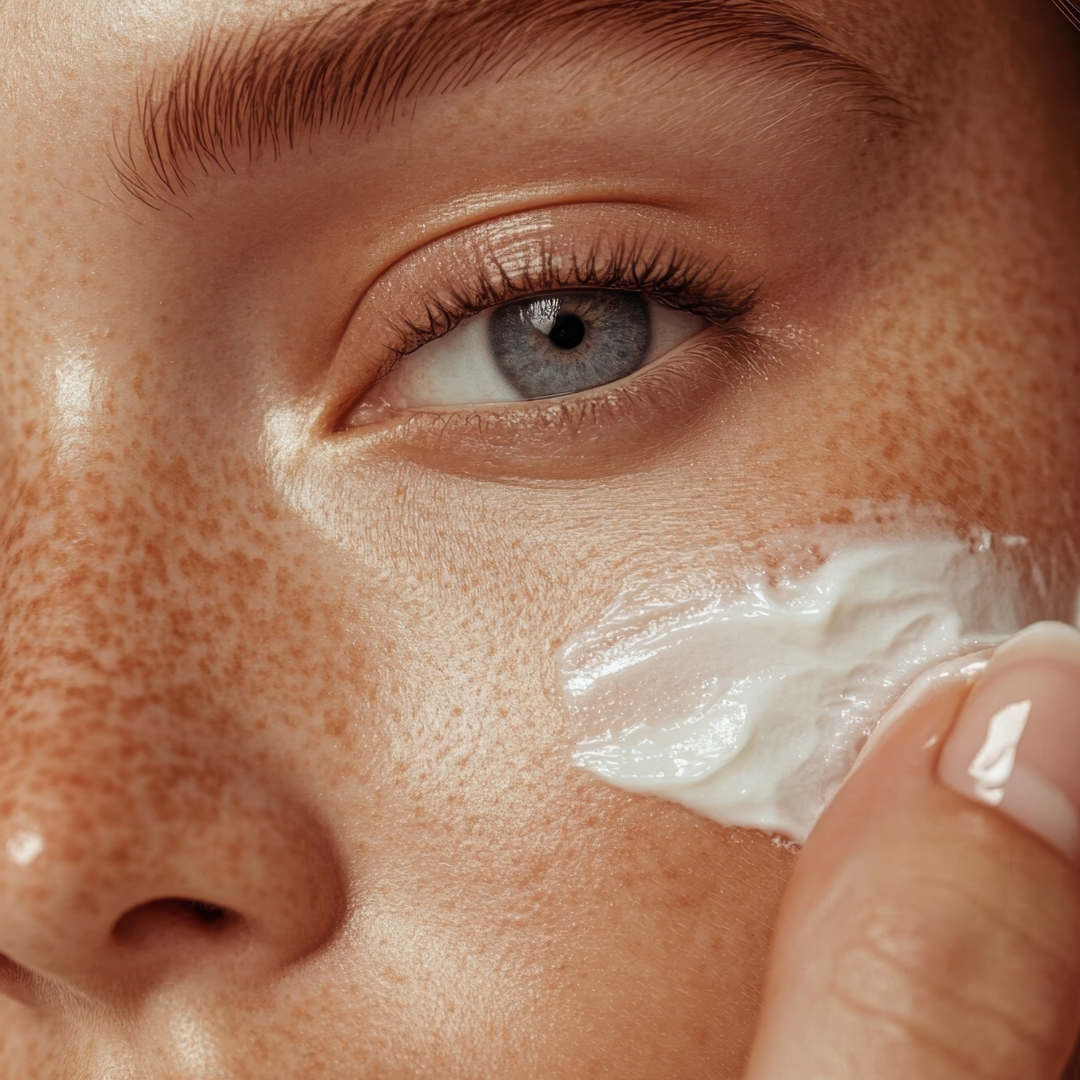A Friendly, In-Depth Guide to Spotting + Treating Common Skin Troubles
Our skin holds onto little stories, dryness from the weather, breakouts from stress, patches that flare when life gets busy, or dark spots left behind by past inflammation. When you learn to recognize each pattern, you can choose gentle, nourishing, toxin-free ways to care for your skin without the overwhelm.
Let’s go deeper into what these conditions look like, what’s happening underneath, and how to support your skin naturally and safely.
1. Eczema (Atopic Dermatitis)
How to Spot It
Eczema can show up differently on everyone, but common signs include:
Rough, dry, cracked patches that sometimes weep or crust
Redness and irritation that comes in cycles
Itching that can be intense, especially at night
Flare-ups around the elbows, hands, neck, eyelids, and behind the knees
Skin that feels thin or sensitive to the touch
What’s Happening Beneath the Surface
Eczema is often linked to:
A weakened or “leaky” skin barrier
Inflammation triggered by irritants, stress, or allergens
Sensitivity to harsh soaps, detergents, or artificial fragrance
Climate changes, especially dry winter air
What May Help
Rich, barrier-supporting moisturizers like tallow cream help lock in hydration.
Cleansing with tallow and goat milk soaps to calm redness and balances the skin’s pH.
Keep your environment humidified (especially in winter) to prevent cracking.
Avoid scented products, chemical-heavy detergents, and long hot showers.
Wear soft, breathable fabrics to reduce irritation.
Addressing gut health.
2. Keratosis Pilaris (KP / “Chicken Skin”)
How to Spot It
KP is one of the most common skin conditions:
Tiny, rough bumps that can feel like sandpaper
Redness around hair follicles
Most common on the arms, thighs, cheeks, and buttocks
Skin can feel dry or tight
What’s Happening Beneath the Surface
Keratin, a natural protein, builds up inside the hair follicle and creates little “caps.” KP is linked to:
Dry skin
Seasonal changes (winter is usually worse)
Genetics
Sensitive skin types
What May Help
Goat milk soap cleansing gently breaks down keratin plugs over time.
Moisturize with tallow body butters right after showering to seal in hydration.
Use castor oil on stubborn patches for softening and smoothing.
Gentle exfoliation with a soft washcloth can help, but avoid scrubs, which irritate KP.
Stay away from artificial fragrance or drying alcohols that worsen bumps.
Gentle dry brushing.
3. Hormonal Acne
How to Spot It
Hormonal acne has a very “predictable” pattern:
Deep, painful cyst-like bumps
Breakouts centered around the jawline, chin, and neck
Flare-ups often synced with menstrual cycles
Skin may look oily but still feel dehydrated or irritated
What’s Happening Beneath the Surface
Hormones influence the skin’s oil glands, leading to:
Increased sebum production
Clogged pores
Deep inflammation
Slower healing times
Triggers include stress, diet changes, sleep disturbances, and imbalanced skincare routines.
What May Help
Oil cleanse with jojoba or castor oil to keep pores clear without stripping.
Apply castor oil as a spot treatment to reduce inflammation and swelling.
Try a serum with cajeput oil to target inflammation.
Simplify your skincare, too many active ingredients overwhelm the skin.
Keep products artificial fragrance free to avoid irritation.
Support your body internally with Zinc + omega-3 rich foods.
Address gut health to steady blood sugar, and balance minerals.
Avoid sugars, dairy, and gluten.
Stay hydrated.
4. Hyperpigmentation
How to Spot It
Hyperpigmentation can appear as:
Dark spots left behind by old acne
Sunspots or age spots
Patches of melasma on the cheeks or forehead
Darkened areas around the mouth
Uneven tone that becomes more noticeable in the sun
What’s Happening Beneath the Surface
Pigment-producing cells (melanocytes) produce excess melanin due to:
UV exposure
Hormonal shifts (pregnancy, birth control)
Inflammation from acne, eczema, or injury
Harsh products that irritate the skin
Heat exposure (even without sun)
What May Help
Vitamin C serum.
Apply rosehip oil for nourishing, even-toning support.
Try niacinamide for calming inflammation and brightening.
Use a mineral SPF daily to stop spots from darkening.
Avoid picking or scrubbing the skin, which worsens pigmentation.
5. Fungal Acne (Malassezia Folliculitis)
How to Spot It
Fungal acne is sneaky because it looks similar to regular acne:
Tiny, uniform bumps that appear in clusters
Often itchy (a big clue!)
Found on the forehead, chest, back, and sometimes shoulders
Doesn’t respond to regular acne treatments
What’s Happening Beneath the Surface
This condition comes from an overgrowth of yeast (malassezia) that lives naturally on the skin. Overgrowth occurs when:
The environment is warm, humid, or sweaty
Heavy oils or creams feed the yeast
Sweat sits on the skin too long
Tight clothing traps moisture
What May Help
Wear breathable fabrics.
Switch to oils like jojoba, tea tree, neem (yeast can’t feed on it)
Cleanse the skin with charcoal soap
Avoid coconut oil and olive oil.
Keep skin clean and dry after workouts.
Use honey masks to balance the microbiome.
Choose lightweight, fragrance-free moisturizers and avoid heavy occlusives on affected areas.
Wash pillowcases and workout clothing frequently to limit yeast buildup.
6. Psoriasis
How to Spot It
Psoriasis has a very distinct look:
Thick, raised plaques with silvery-white scales
Bright red or pink inflammation beneath the scaling
Patches that are tender or itchy
Commonly found on elbows, knees, lower back, scalp, and sometimes nails
Nails may have pitting or ridges
What’s Happening Beneath the Surface
Psoriasis is an autoimmune-driven condition where:
Skin cells turn over much faster than normal
Layers of skin stack up, creating plaques
Triggers include stress, certain medications, cold weather, infections, and skin injuries
What May Help
Tallow body butter to deeply soften plaques and reduce scaling.
Goat milk soap provides gentle lactic acid for mild exfoliation.
Warm compresses help loosen thick scales without damaging skin.
Controlled sun exposure can calm inflammation.
Keep your routine simple, as fragrance and chemical irritants often trigger flare-ups.
Address your gut health, cutting out sugars and inflammatory foods.
7. Fine Lines
What it appears as
Soft, shallow creases around the eyes (“crow’s feet”), forehead, or mouth
Slight crinkling when you smile or squint
Texture changes that show up after sun exposure or dehydration
Lines that are more noticeable in dry seasons or after wearing makeup
These early lines are usually connected to dryness, expression habits, sun exposure, and the natural aging process.
What’s Happening Beneath the Surface
Fine lines begin forming when the skin’s building blocks collagen, elastin, and hydration start to shift. Common contributors include:
UV exposure, which breaks down collagen more quickly
Dehydration, leaving the skin less plump
Loss of natural oils, often from harsh cleansers or over-exfoliating
Repetitive facial expressions (totally normal and human!)
Environmental stressors, like pollution and dry air
Exhaustion whether from lack of sleep, stress, overworking, or hormonal shifts reduces collagen production and slows down skin repair
Aging, which naturally slows cell turnover
What May Help
You can soften fine lines beautifully with the right gentle, natural habits:
Deep nourishment with tallow face creamTallow mimics our skin’s natural oils, helping it stay hydrated, supple, and resilient.
Practice facial massageHelps boost circulation, reduce tension, and improve absorption of natural skincare.
Focus on sun protectionA mineral, chemical-free SPF helps prevent new lines from forming.
Stay artificial fragrance freeFragrance is a hidden aging accelerant for sensitive skin because it increases inflammation and dryness.
Hydrate internallyElectrolytes, healthy fats, and steady hydration help keep skin plump from the inside out.
Sleep and stress supportSkin repairs itself at night even minor improvements in sleep or stress can soften visible lines.
For tips on a healthy, customizable skincare routine, check out our routine guide here.
The goal isn’t perfect skin but to understand your skin. When you listen to your body and choose gentle, chemical-free skincare, your skin finally gets the break it needs to heal, strengthen, and glow in its own way.




















